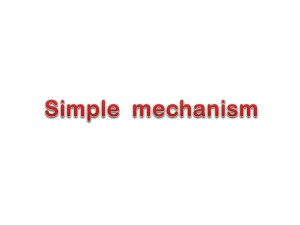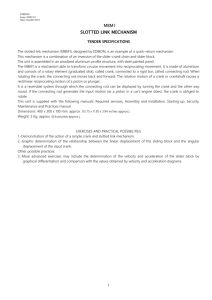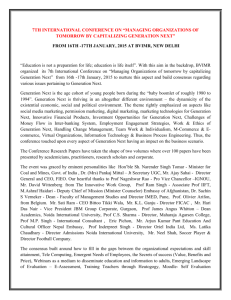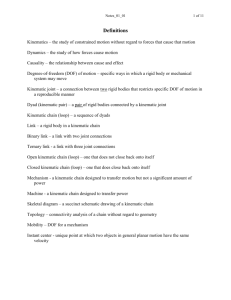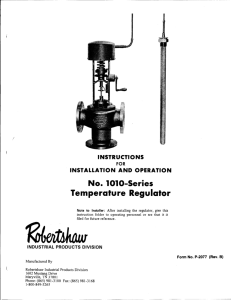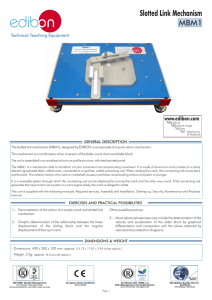ME-403 Theory of MC and Mechanism_2
advertisement
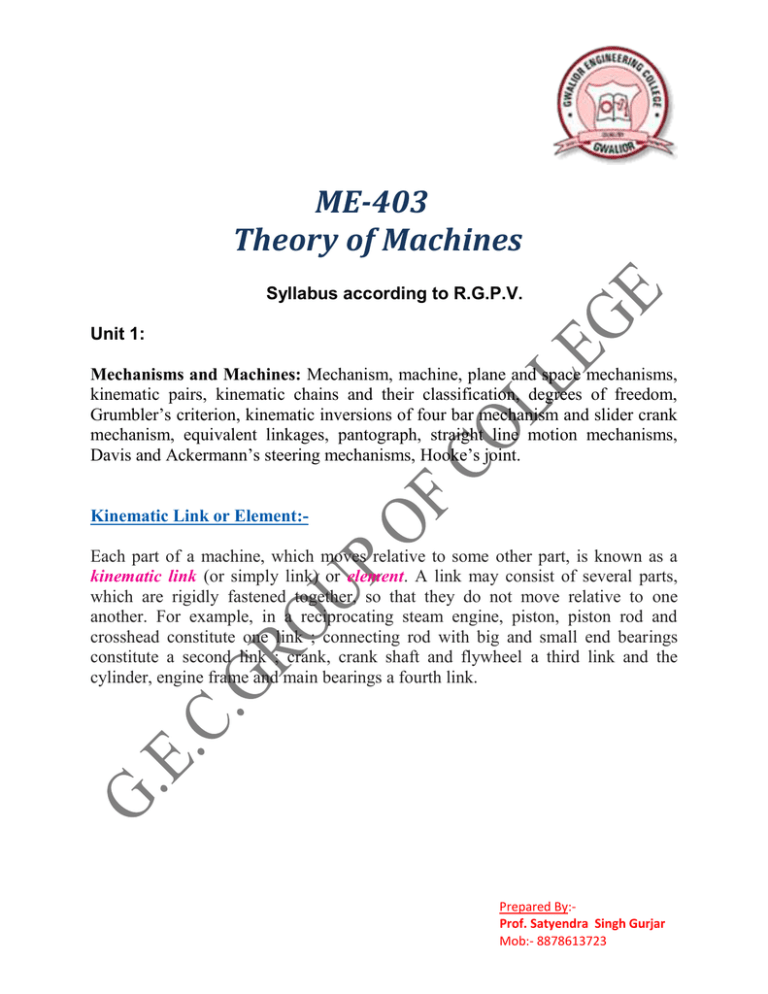
ME-403 Theory of Machines Syllabus according to R.G.P.V. Unit 1: Mechanisms and Machines: Mechanism, machine, plane and space mechanisms, kinematic pairs, kinematic chains and their classification, degrees of freedom, Grumbler’s criterion, kinematic inversions of four bar mechanism and slider crank mechanism, equivalent linkages, pantograph, straight line motion mechanisms, Davis and Ackermann’s steering mechanisms, Hooke’s joint. Kinematic Link or Element:Each part of a machine, which moves relative to some other part, is known as a kinematic link (or simply link) or element. A link may consist of several parts, which are rigidly fastened together, so that they do not move relative to one another. For example, in a reciprocating steam engine, piston, piston rod and crosshead constitute one link ; connecting rod with big and small end bearings constitute a second link ; crank, crank shaft and flywheel a third link and the cylinder, engine frame and main bearings a fourth link. Prepared By:Prof. Satyendra Singh Gurjar Mob:- 8878613723 A link or element need not to be a rigid body, but it must be a resistant body. A body is said to be a resistant body if it is capable of transmitting the required forces with negligible deformation. Thus a link should have the following two characteristics: 1. It should have relative motion, and 2. It must be a resistant body. Types of Links:In order to transmit motion, the driver and the follower may be connected by the following three types of links :1. Rigid link:- A rigid link is one which does not undergo any deformation while transmitting motion. Strictly speaking, rigid links do not exist. However, as the deformation of a connecting rod, crank etc. of a reciprocating steam engine is not appreciable, they can be considered as rigid links. 2. Flexible link:- A flexible link is one which is partly deformed in a manner not to affect the transmission of motion. For example, belts, ropes, chains and wires are flexible links and transmit tensile forces only. Prepared By:Prof. Satyendra Singh Gurjar Mob:- 8878613723 3. Fluid link:- A fluid link is one which is formed by having a fluid in a receptacle and the motion is transmitted through the fluid by pressure or compression only, as in the case of hydraulic presses, jacks and brakes. Kinematic Pair:The two links or elements of a machine, when in contact with each other, are said to form a pair. If the relative motion between them is completely or successfully constrained (i.e. in a definite direction), the pair is known as kinematic pair. Types of Constrained Motions:- Following are the three types of constrained motions: 1. Completely constrained motion:- When the motion between a pair is limited to a definite direction irrespective of the direction of force applied, then the motion is said to be a completely constrained motion. For example, the piston and cylinder (in a steam engine) form a pair and the motion of the piston is limited to a definite direction (i.e. it will only reciprocate) relative to the cylinder irrespective of the direction of motion of the crank The motion of a square bar in a square hole, and the motion of a shaft with collars at each end in a circular hole, are also examples of completely constrained motion. Prepared By:Prof. Satyendra Singh Gurjar Mob:- 8878613723 2. Incompletely constrained motion:- When the motion between a pair can take place in more than one direction, then the motion is called an incompletely constrained motion. The change in the direction of impressed force may alter the direction of relative motion between the pair. A circular bar or shaft in a circular hole, is an example of an incompletely constrained motion as it may either rotate or slide in a hole. These both motions have no relationship with the other. 3. Successfully constrained motio:-. When the motion between the elements, forming a pair,is such that the constrained motion is not completed by itself, but by some other means, then the motion is said to be successfully constrained motion. Consider a shaft in a foot-step bearing as . The shaft may rotate in a bearing or it may move upwards. This is a case of incompletely constrained motion. But if the load is placed on the shaft to prevent axial upward movement of the shaft, then the motion of the pair is said to be successfully constrained motion. The motion of an I.C. enginevalve (these are kept on their seat by a spring) and the piston reciprocating inside an engine cylinder are also the examples of successfully constrained motion. Prepared By:Prof. Satyendra Singh Gurjar Mob:- 8878613723 Classification of Kinematic Pairs:-The kinematic pairs may be classified according to the following considerations : 1. According to the type of relative motion between the elements:- The kinematic pairs according to type of relative motion between the elements may be classified as discussed below: (a) Sliding pair:- When the two elements of a pair are connected in such a way that one can only slide relative to the other, the pair is known as a sliding pair. The piston and cylinder, cross-head and guides of a reciprocating steam engine, ram and its guides in shaper, tail stock on the lathe bed etc. are the examples of a sliding pair. A little consideration will show, that a sliding pair has a completely constrained motion. (b) Turning pair:- When the two elements of a pair are connected in such a way that one can only turn or revolve about a fixed axis of another link, the pair is known as turning pair. A shaft with collars at both ends fitted into a circular hole, the crankshaft in a journal bearing in an engine, lathe spindle supported in head stock, cycle wheels turning over their axles etc. are the examples of a turning pair. A turning pair also has a completely constrained motion. (c) Rolling pair:- When the two elements of a pair are connected in such a way that one rolls over another fixed link, the pair is known as rolling pair. Ball and roller bearings are examples of rolling pair. (d) Screw pair:- When the two elements of a pair are connected in such a way that one element can turn about the other by screw threads, the pair is known as screw pair. The lead screw of a lathe with nut, and bolt with a nut are examples of a screw pair. (e) Spherical pair:- When the two elements of a pair are connected in such a way that one element (with spherical shape) turns or swivels about the other fixed element, the pair formed is called a spherical pair. The ball and socket joint, attachment of a car mirror, pen stand etc., are the examples of a spherical pair. Prepared By:Prof. Satyendra Singh Gurjar Mob:- 8878613723 2. According to the type of contact between the elements:- The kinematic pairs according to the type of contact between the elements may be classified as discussed below : (a) Lower pair:- When the two elements of a pair have a surface contact when relative motion takes place and the surface of one element slides over the surface of the other, the pair formed is known as lower pair. It will be seen that sliding pairs, turning pairs and screw pairs form lower pairs. (b) Higher pair:- When the two elements of a pair have a line or point contact when relative motion takes place and the motion between the two elements is partly turning and partly sliding,then the pair is known as higher pair. A pair of friction discs, toothed gearing, belt and rope drives, ball and roller bearings and cam and follower are the examples of higher pairs. 3. According to the type of closure:-. The kinematic pairs according to the type of closure between the elements may be classified as discussed below : (a) Self closed pair:-. When the two elements of a pair are connected together mechanically in such a way that only required kind of relative motion occurs, it is then known as self closed pair. The lower pairs are self closed pair. (b) Force - closed pair:-. When the two elements of a pair are not connected mechanically but are kept in contact by the action of external forces, the pair is said to be a force-closed pair. The cam and follower is an example of force closed pair, as it is kept in contact by the forces exerted by spring and gravity. Kinematic Chain:When the kinematic pairs are coupled in such a way that the last link is joined to the first link to transmit definite motion (i.e. completely or successfully constrained motion), it is called a kinematic chain. In other words, a kinematic chain may be defined as a combination of kinematic pairs, joined in such a way that each link forms a part of two pairs and the relative motion between the links or elements is Prepared By:Prof. Satyendra Singh Gurjar Mob:- 8878613723 completely or successfully constrained. For example, the crankshaft of an engine forms a kinematic pair with the bearings which are fixed in a pair, the connecting rod with the crank forms a second kinematic pair, the piston with the connecting rod forms a third pair and the piston with the cylinder forms a fourth pair. The total combination of these links is a kinematic chain. Types of Joints in a Chain:- The following types of joints are usually found in a chain : 1. Binary joint:-. When two links are joined at the same connection, the joint is known as binary joint. For example, a chain has four links and four binary joins at A, B, C and D. In order to determine the nature of chain, i.e. whether the chain is a locked chain (or structure) or kinematic chain or unconstrained chain, the following relation between the number of links and the number of binary joints, as given by A.W. Klein, may be used : ℎ 3 𝑗+ = 𝑙−2 2 2 Where j = Number of binary joints, h = Number of higher pairs, and l = Number of links. Ternary joint:-. When three links are joined at the same connection, the joint is known as ternary joint. It is equivalent to two binary joints as one of the three links joined carry the pin for the other two links. For example, a chain, has six links. It has three binary joints at A, B and D and two ternary joints at C and E. Since one Prepared By:Prof. Satyendra Singh Gurjar Mob:- 8878613723 ternary joint is equivalent to two binary joints, therefore equivalent binary joints in a chain, Quaternary joint:-. When four links are joined at the same connection, the joint is called a quaternary joint. It is equivalent to three binary joints. In general, when l number of links are joined at the same connection, the joint is equivalent to (l – 1) binary joints. For example consider a chain having eleven links, It has one binary joint at D, four ternary joints at A, B, E and F, and two quaternary joints at C and G. Since one quaternary joint is equivalent to three binary joints and one ternary joint is equal to two binary joints, therefore total number of binary joints in a chain, Number of Degrees of Freedom for Plane Mechanisms:In the design or analysis of a mechanism, one of the most important concern is the number of degrees of freedom (also called movability) of the mechanism. It is Prepared By:Prof. Satyendra Singh Gurjar Mob:- 8878613723 defined as the number of input parameters (usually pair variables) which must be independently controlled in order to bring the mechanism into a useful engineering purpose. It is possible to determine the number of degrees of freedom of a mechanism directly from the number of links and the number and types of joints which it includes. Consider a four bar chain, A little consideration will show that only one variable such as define the relative positions of all the links. In other words, we say that the number of degrees of freedom of a four bar chain is one. Now, let us consider a five bar chain, In this case two variables such as and are needed to define completely the relative positions of all the links. Thus, we say that the number of degrees of freedom is two. In order to develop the relationship in general, consider two links AB and CD in a plane motion, The link AB with co-ordinate system OXY is taken as the reference link (or fixed link). The position of point P on the moving link CD can be completely specified by the three variables, i.e. the co-ordinates of the point P denoted by x and y and CD with X-axis or link AB. In other words, we can say that each link of a mechanism has three degrees of freedom before it is connected to any other link. But when the link CD is connected to the link AB by a Prepared By:Prof. Satyendra Singh Gurjar Mob:- 8878613723 turning pair at A, as, the position of link CD is now determined by a single variable has one degree of freedom. From above, we see that when a link is connected to a fixed link by a turning pair (i.e. lower pair), two degrees of freedom are destroyed. This may be clearly understood from, in which the resulting four bar mechanism has one degree of freedom (i.e. n = 1 ). Now let us consider a plane mechanism with l number of links. Since in a mechanism, one of the links is to be fixed, therefore the number of movable links will be (l – 1) and thus the total number of degrees of freedom will be 3 (l – 1) before they are connected to any other link. In general, a mechanism with l number of links connected by j number of binary joints or lower pairs (i.e. single degree of freedom pairs) and h number of higher pairs (i.e. two degree of freedom pairs), then the number of degrees of freedom of a mechanism is given by n = 3 (l – 1) – 2 j – h This equation is called Kutzbach criterion for the movability of a mechanism having plane motion.If there are no two degree of freedom pairs (i.e. higher pairs), then h = 0. Substituting h = 0 in equation (i), we have n = 3 (l – 1) – 2 j Prepared By:Prof. Satyendra Singh Gurjar Mob:- 8878613723 Application of Kutzbach Criterion to Plane Mechanisms:- The number of degrees of freedom or movability (n) for some simple mechanisms having no higher pair (i.e. h = 0), are determined as follows : 1. The mechanism, as shown in Fig. 5.16 (a), has three links and three binary joints, i.e. l = 3 and j = 3. n = 3 (3 – 1) – 2 × 3 = 0 2. The mechanism, has four links and four binary joints, i.e. l = 4 and j = 4. n = 3 (4 – 1) – 2 × 4 = 1 3. The mechanism, has five links and five binary joints, i.e. l = 5, and j = 5. n = 3 (5 – 1) – 2 × 5 = 2 4. The mechanism, has five links and six equivalent binary joints (because there are two binary joints at B and D, and two ternary joints at A and C), i.e. l = 5 and j = 6. n = 3 (5 – 1) – 2 × 6 = 0 5. The mechanism, has six links and eight equivalent binary joints (because there are four ternary joints at A, B, C and D), i.e. l = 6 and j = 8. n = 3 (6 – 1) – 2 × 8 = – 1 It may be noted that Prepared By:Prof. Satyendra Singh Gurjar Mob:- 8878613723 (a) When n = 0, then the mechanism forms a structure and no relative motion between the links is possible, (b) When n = 1, then the mechanism can be driven by a single input motion, (c) When n = 2, then two separate input motions are necessary to produce constrained motion for the mechanism, (d) When n = – 1 or less, then there are redundant constraints in the chain and it forms a statically indeterminate structure, The application of Kutzbach’s criterion applied to mechanisms with a higher pair or two degree of freedom joints there are three links, two binary joints and one higher pair, i.e. l = 3, j = 2 and h = 1. n = 3 (3 – 1) – 2 × 2 – 1 = 1 there are four links, three binary joints and one higher pair, i.e. l = 4, j = 3 and h = 1 n = 3 (4 – 1) – 2 × 3 – 1 = 2 Here it has been assumed that the slipping is possible between the links (i.e. between the wheel and the fixed link). However if the friction at the contact is high enough to prevent slipping, the joint will be counted as one degree of freedom pair, because only one relative motion will be possible between the links. Grubler’s Criterion for Plane Mechanisms:The Grubler’s criterion applies to mechanisms with only single degree of freedom joints where the overall movability of the mechanism is unity. Substituting n = 1 and h = 0 in Kutzbach equation, we have 1 = 3 (l – 1) – 2 j or 3l – 2j – 4 = 0 Prepared By:Prof. Satyendra Singh Gurjar Mob:- 8878613723 This equation is known as the Grubler's criterion for plane mechanisms with constrained motion. A little consideration will show that a plane mechanism with a movability of 1 and only single degree of freedom joints can not have odd number of links. The simplest possible machanisms of this type are a four bar mechanism and a slider-crank mechanism in which l = 4 and j = 4. Inversion of Mechanism:when one of links is fixed in a kinematic chain, it is called a mechanism. So we can obtain as many mechanisms as the number of links in a kinematic chain by fixing, in turn, different links in a kinematic chain. This method of obtaining different mechanisms by fixing different links in a kinematic chain, is known as inversion of the mechanism. Types of Kinematic Chains:1. Four bar chain or quadric cyclic chain, 2. Single slider crank chain, and 3. Double slider crank chain. Four Bar Chain or Quadric Cycle Chain:We have already discussed that the kinematic chain is a combination of four or more kinematic pairs, such that the relative motion between the links or elements is completely constrained. The simplest and the basic kinematic chain is a four bar chain or quadric cycle chain, It consists of four links, each of them forms a turning pair at A, B, C and D. The four links may be of different lengths. According to Grashof ’s law for a four bar mechanism, the sum of the shortest and longest link lengths should not be greater than the sum of the remaining two link lengths if there is to be continuous relative motion between the two links. Prepared By:Prof. Satyendra Singh Gurjar Mob:- 8878613723 A very important consideration in designing a mechanism is to ensure that the input crank makes a complete revolution relative to the other links. The mechanism in which no link makes a complete revolution will not be useful. In a four bar chain, one of the links, in particular the shortest link, will make a complete revolution relative to the other three links, if it satisfies the Grashof ’s law. Such a link is known as crank or driver. AD (link 4 ) is a crank. The link BC (link 2) which makes a partial rotation or oscillates is known as lever or rocker or follower and the link CD (link 3) which connects the crank and lever is called connecting rod or coupler. The fixed link AB (link 1) is known as frame of the mechanism. Inversions of Four Bar Chain:1. Beam engine (crank and lever mechanism):- A part of the mechanism of a beam engine (also known as crank and lever mechanism) which consists of four links. In this mechanism, when the crank rotates about the fixed centre A, the lever oscillates about a fixed centre D. The end E of the lever CDE is connected to a piston rod which reciprocates due to the rotation of the crank. In other words, the purpose of this mechanism is to convert rotary motion into reciprocating motion Prepared By:Prof. Satyendra Singh Gurjar Mob:- 8878613723 2. Coupling rod of a locomotive (Double crank mechanism):- The mechanism of a coupling rod of a locomotive (also known as double crank mechanism) which consists of four links. In this mechanism, the links AD and BC (having equal length) act as cranks and are connected to the respective wheels. The link CD acts as a coupling rod and the link AB is fixed in order to maintain a constant centre to centre distance between them. This mechanism is meant for transmitting rotary motion from one wheel to the other wheel. 3. Watt’s indicator mechanism (Double lever mechanism):- AWatt’s indicator mechanism (also known as Watt's straight line mechanism or double lever mechanism) which consists of four links, is shown in Fig. 5.21. The four links are : fixed link at A, link AC, link CE and link BFD. It may be noted that BF and FD form one link because these two parts have no relative motion between them. The links CE and BFD act as levers. The displacement of the link BFD is directly proportional to the pressure of gas or steam which acts on the indicator plunger. On any small displacement of the mechanism, the tracing point E at the end of the link CE traces out approximately a straight line. The initial position of the mechanism is by full lines whereas the dotted lines show the position of the mechanism when the gas or steam pressure acts on the indicator plunger. Prepared By:Prof. Satyendra Singh Gurjar Mob:- 8878613723 Single Slider Crank Chain:A single slider crank chain is a modification of the basic four bar chain. It consist of one sliding pair and three turning pairs. It is,usually, found in reciprocating steam engine mechanism. This type of mechanism converts rotary motion into reciprocating motion and vice versa. In a single slider crank chain, the links 1 and 2, links 2 and 3, and links 3 and 4 form three turning pairs while the links 4 and 1 form a sliding pair. The link 1 corresponds to the frame of the engine, which is fixed. The link 2 corresponds to the crank ; link 3 corresponds to the connecting rod and link 4 corresponds to cross-head. As the crank rotates, the cross-head reciprocates in the guides and thus the piston reciprocates in the cylinder. Prepared By:Prof. Satyendra Singh Gurjar Mob:- 8878613723 Inversions of Single Slider Crank Chain:1. Pendulum pump or Bull engine:- In this mechanism, the inversion is obtained by fixing the cylinder or link 4 (i.e. sliding pair), In this case, when the crank (link 2) rotates, the connecting rod (link 3) oscillates about a pin pivoted to the fixed link 4 at A and the piston attached to the piston rod (link 1) reciprocates. The duplex pump which is used to supply feed water to boilers have two pistons attached to link 1, 2. Oscillating cylinder engine:- The arrangement of oscillating cylinder engine mechanism, is used to convert reciprocating motion into rotary motion. In this mechanism, the link 3 forming the turning pair is fixed. The link 3 corresponds to the connecting rod of a reciprocating steam engine mechanism. When the crank (link 2) rotates, the piston attached to piston rod (link 1) reciprocates and the cylinder (link 4) oscillates about a pin pivoted to the fixed link at A. 3. Rotary internal combustion engine or Gnome engine:- Sometimes back, rotary internal combustion engines were used in aviation. But now-a-days gas turbines are used in its place. It consists of seven cylinders in one plane and all revolves about fixed centre D, as shown in Fig. 5.25, while the crank (link 2) is fixed. In this mechanism, when the connecting rod (link 4) rotates, the piston (link 3) reciprocates inside the cylinders forming link 1. Prepared By:Prof. Satyendra Singh Gurjar Mob:- 8878613723 4. Crank and slotted lever quick return motion mechanism. This mechanism is mostly used in shaping machines, slotting machines and in rotary internal combustion engines.Rotary engine In this mechanism, the link AC (i.e. link 3) forming the turning pair is fixed, The link 3 corresponds to the connecting rod of a reciprocating steam engine. The driving crank CB revolves with uniform angular speed about the fixed centre C. A sliding block attached to the crank pin at B slides along the slotted bar AP and thus causes AP to oscillate about the pivoted point A. A short link PR transmits the motion from AP to the ram which carries the tool and reciprocates along the line of stroke R1R2. The line of stroke of the ram (i.e. R1R2) is perpendicular to AC produced. Prepared By:Prof. Satyendra Singh Gurjar Mob:- 8878613723 In the extreme positions, AP1 and AP2 are tangential to the circle and the cutting tool is at the end of the stroke. The forward or cutting stroke occurs when the crank rotates from the position CB1 to CB2 (or through an angle ) in the clockwise direction. The return stroke occurs when the crank rotates from the position CB2 to CB1 (or through angle ) in the clockwise direction. Since the crank has uniform angular speed, therefore, Whitworth quick return motion mechanism:- This mechanism is mostly used in shaping and slotting machines. In this mechanism, the link CD (link 2) forming the turning pair is fixed. The link 2 corresponds to a crank in a reciprocating steam engine. The driving crank CA (link 3) rotates at a uniform angular speed. The slider (link 4) attached to the crank pin at A slides along the slotted bar PA (link 1) which oscillates at a pivoted point D. The connecting rod PR carries the ram at R to which a cutting tool is fixed. The motion of the tool is constrained along the line RD produced, i.e. along a line passing through D and perpendicular to CD. Prepared By:Prof. Satyendra Singh Gurjar Mob:- 8878613723 When the driving crank CA moves from the position CA1 to CA2 (or the link DP from the position DP1 to DP2) through an angle in the clockwise direction, the tool moves from the left hand end of its stroke to the right hand end through a distance 2 PD. Now when the driving crank moves from the position CA2 to CA1 (or the link DP from DP2 to DP1 ) through an angle the tool moves back from right hand end of its stroke to the left hand end. A little consideration will show that the time taken during the left to right movement of the ram (i.e. during forward or cutting stroke) will be equal to the time taken by the driving crank to move from CA1 to CA2. Similarly, the time taken during the right to left movement of the ram (or during the idle or return stroke) will be equal to the time taken by the driving crank to move from CA2 to CA1. Since the crank link CA rotates at uniform angular velocity therefore time taken during the cutting stroke (or forward stroke) is more than the time taken during the return stroke. In other words, the mean speed of the ram during cutting stroke is less than the mean speed during the return stroke. The ratio between the time taken during the cutting and return strokes is given by Prepared By:Prof. Satyendra Singh Gurjar Mob:- 8878613723 Double Slider Crank Chain:A kinematic chain which consists of two turning pairs and two sliding pairs is known as double slider crank chain, We see that the link 2 and link 1 form one turning pair and link 2 and link 3 form the second turning pair. The link 3 and link 4 form one sliding pair and link 1 and link 4 form the second sliding pair. Inversions of Double Slider Crank Chain:1. Elliptical trammels:-. It is an instrument used for drawing ellipses. This inversion is obtained by fixing the slotted plate (link 4), The fixed plate or link 4 has two straight grooves cut in it, at right angles to each other. The link 1 and link 3, are known as sliders and form sliding pairs with link 4. The link AB (link 2) is a bar which forms turning pair with links 1 and 3. When the links 1 and 3 slide along their respective grooves, any point on the link 2 such as P traces out an ellipse on the surface of link 4. A little consideration will show that AP and BP are the semi-major axis and semiminor axis of the ellipse respectively. This can be proved as follows: Prepared By:Prof. Satyendra Singh Gurjar Mob:- 8878613723 2. Scotch yoke mechanism:- This mechanism is used for converting rotary motion into a reciprocating motion. The inversion is obtained by fixing either the link 1 or link 3. In Fig. 5.35, link 1 is fixed. In this mechanism, when the link 2 (which corresponds to crank) rotates about B as centre, the link 4 (which corresponds to a frame) reciprocates. The fixed link 1 guides the frame. Prepared By:Prof. Satyendra Singh Gurjar Mob:- 8878613723 3. Oldham’s coupling:- An oldham's coupling is used for connecting two parallel shafts whose axes are at a small distance apart. The shafts are coupled in such a way that if one shaft rotates, the other shaft also rotates at the same speed. This inversion is obtained by fixing the link 2. The shafts to be connected have two flanges (link 1 and link 3) rigidly fastened at their ends by forging. The link 1 and link 3 form turning pairs with link 2. These flanges have diametrical slots cut in their inner faces. The intermediate piece (link 4) which is a circular disc, have two tongues (i.e. diametrical projections) T1 and T2 on each face at right angles to each other. The tongues on the link 4 closely fit into the slots in the two flanges (link 1 and link 3). The link 4 can slide or reciprocate in the slots in the flanges. When the driving shaft A is rotated, the flange C (link 1) causes the intermediate piece (link 4) to rotate at the same angle through which the flange has rotated, and it further rotates the flange D (link 3) at the same angle and thus the shaft B rotates. Hence links 1, 3 and 4 have the same angular velocity at every instant. A little consideration will show, that there is a sliding motion between the link 4 and each of the other links 1 and 3. If the distance between the axes of the shafts is constant, the centre of intermediate piece will describe a circle of radius equal to the distance between the axes of the two shafts. Therefore, the maximum sliding speed of each tongue along its slot is equal to the peripheral velocity of the centre Prepared By:Prof. Satyendra Singh Gurjar Mob:- 8878613723 of the disc along its circular path. Let r = Distance between the axes of the shafts in metres. Maximum sliding speed of each tongue (in m/s), v = .r Pantograph:A pantograph is an instrument used to reproduce to an enlarged or a reduced scale and as exactly as possible the path described by a given point. It consists of a jointed parallelogram ABCD as shown in Fig. 9.1. It is made up of bars connected by turning pairs. The bars BA and BC are extended to O and E respectively, such that OA/OB = AD/BE Thus, for all relative positions of the bars, the triangles OAD and OBE are similar and the points O, D and E are in one straight line. It may be proved that point E traces out the same path as described by point D.From similar triangles OAD and OBE, we find that OD/OE = AD/BE Let point O be fixed and the points D and E move to some new positions D E'. Then OD/OE = OD'/OE' A little consideration will show that the straight line DD' is parallel to the straight line EE'. Hence, if O is fixed to the frame of a machine by means of a turning pair and D is attached to a point in the machine which has rectilinear motion relative to Prepared By:Prof. Satyendra Singh Gurjar Mob:- 8878613723 the frame, then E will also trace out a straight line path. Similarly, if E is constrained to move in a straight line, then D will trace out a straight line parallel to the former. A pantograph is mostly used for the reproduction of plane areas and figures such as maps, plans etc., on enlarged or reduced scales. It is, sometimes, used as an indicator rig in order to reproduce to a small scale the displacement of the crosshead and therefore of the piston of a reciprocating steam engine. It is also used to guide cutting tools. A modified form of pantograph is used to collect power at the top of an electric locomotive. Straight Line Mechanisms:One of the most common forms of the constraint mechanisms is that it permits only relative motion of an oscillatory nature along a straight line. The mechanisms used for this purpose are called straight line mechanisms. These mechanisms are of the following two types: 1. in which only turning pairs are used, and 2. in which one sliding pair is used. These two types of mechanisms may produce exact straight line motion or approximate straight line motion, as discussed in the following articles. Exact Straight Line Motion Mechanisms Made up of Turning Pairs:The principle adopted for a mathematically correct or exact straight line motion is described in Fig.9.2. Let O be a point on the circumference of a circle of diameter OP. Let OA be any chord and B is a point on OA produced, such that OA × OB = constant Then the locus of a point B will be a straight line perpendicular to the diameter OP. This may be proved as follows: Draw BQ perpendicular to OP produced. Join AP. The triangles OAP and OBQ are similar. Prepared By:Prof. Satyendra Singh Gurjar Mob:- 8878613723 But OP is constant as it is the diameter of a circle, therefore, if OA × OB is constant, then OQ will be constant. Hence the point B moves along the straight path BQ which is perpendicular to OP. Davis Steering Gear:The Davis steering gear is shown in Fig. 9.16. It is an exact steering gear mechanism. The slotted links AM and BH are attached to the front wheel axle, which turn on pivots A and B respectively. The rod CD is constrained to move in the direction of its length, by the sliding members at P and Q. These constraints are connected to the slotted link AM and BH by a sliding and a turning pair at each end. The steering is affected by moving CD to the right or left of its normal position. C 'D' shows the position of CD for turning to the left. Prepared By:Prof. Satyendra Singh Gurjar Mob:- 8878613723 Prepared By:Prof. Satyendra Singh Gurjar Mob:- 8878613723 Ackerman Steering Gear:The Ackerman steering gear mechanism is much simpler than Davis gear. The difference between the Ackerman and Davis steering gears are : 1. The whole mechanism of the Ackerman steering gear is on back of the front wheels; whereas in Davis steering gear, it is in front of the wheels. 2. The Ackerman steering gear consists of turning pairs, whereas Davis steering gear consists of sliding members. Prepared By:Prof. Satyendra Singh Gurjar Mob:- 8878613723 In Ackerman steering gear, the mechanism ABCD is a four bar crank chain, The shorter links BC and AD are of equal length and are connected by hinge joints with front wheel axles. The longer links AB and CD are of unequal length. The following are the only three positions for correct steering. 1. When the vehicle moves along a straight path, the longer links AB and CD are parallel and the shorter links BC and AD are equally inclined to the longitudinal axis of the vehicle, as shown by firm lines 2. When the vehicle is steering to the left, the position of the gear is shown by dotted lines In this position, the lines of the front wheel axle intersect on the back wheel axle at I, for correct steering. 3. When the vehicle is steering to the right, the similar position may be obtained. In order to satisfy the fundamental equation for correct steering, as discussed in the links AD and DC either graphically or by calculations. Prepared By:Prof. Satyendra Singh Gurjar Mob:- 8878613723 Universal or Hooke’s Joint:A Hooke’s joint is used to connect two shafts, which are intersecting at a small angle. The end of each shaft is forked to U-type and each fork provides two bearings for the arms of a cross. The arms of the cross are perpendicular to each other. The motion is transmitted from the driving shaft to driven shaft through a cross. The inclination of the two shafts may be constant, but in actual practice it varies, when the motion is transmitted. The main application of the Universal or Hooke’s joint is found in the transmission from the gear box to the differential or back axle of the automobiles. It is also used for transmission of power to different spindles of multiple drilling machine. It is also used as a knee joint in milling machines. Prepared By:Prof. Satyendra Singh Gurjar Mob:- 8878613723

